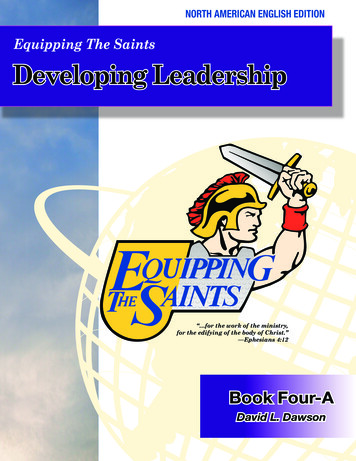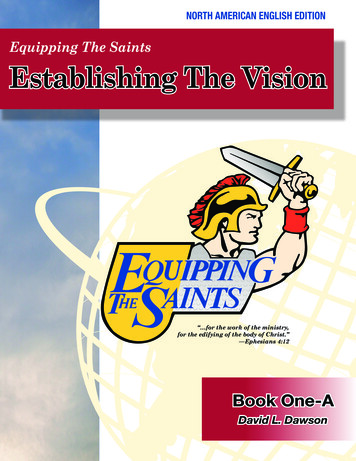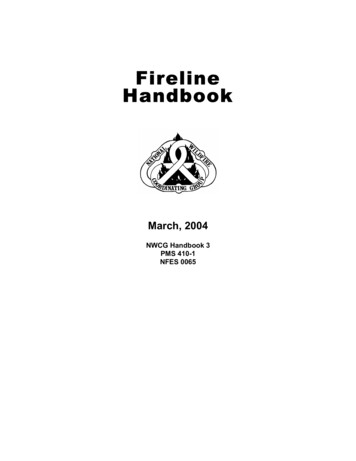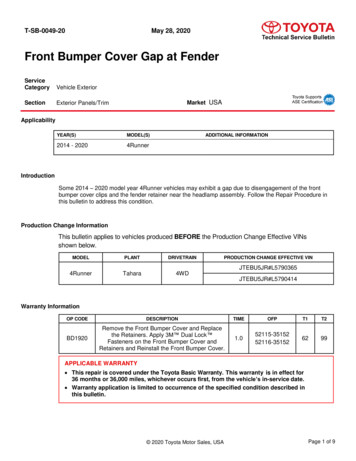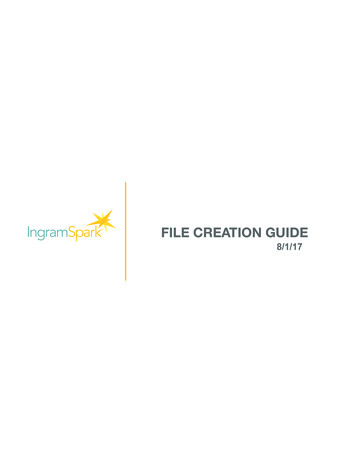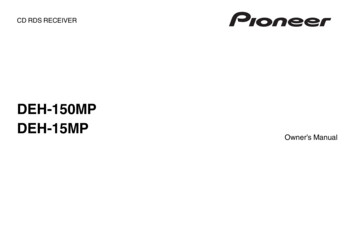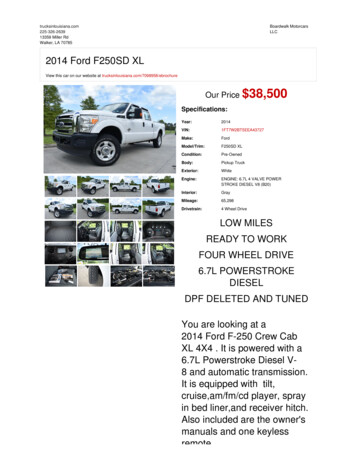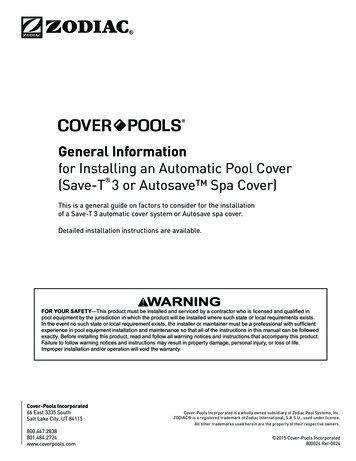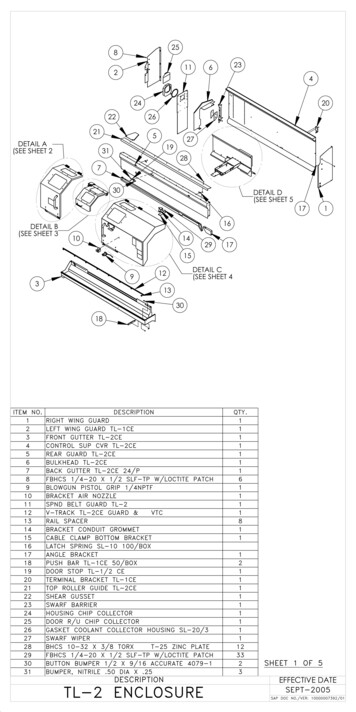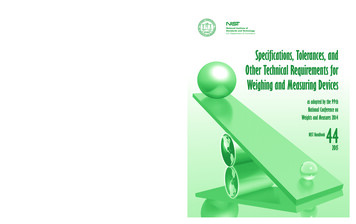
Transcription
U.S Department of CommerceNational Institute of Standards and TechnologyGaithersburg, MD 20899 Stop 2600as adopted by the 99thNational Conference onWeights and Measures 20142015MEDIA MAILUS Postage and fees PaidSuburban MD 20898Permit No 60862015
INSIDE FRONT COVER –INTENTIONALLY LEFT BLANK
Specifications, Tolerances, andOther Technical Requirements forWeighing and Measuring Devicesas adopted by the 99th National Conference on Weights and Measures 2014Editors:Tina ButcherLinda CrownRick HarshmanJuana WilliamsCarol Hockert, ChiefOffice of Weights and MeasuresPhysical Measurement mber 2014U. S. Department of CommercePenny Pritzker, SecretaryNational Institute of Standards and TechnologyWillie May, Acting Under Secretary of Commerce for Standards and Technology and Acting DirectorNIST Handbook442015 EditionSupersedes NIST Handbook 44, 2014 Edition
Certain commercial entities, equipment, or materials may be identified in this document in order to describe anexperimental procedure or concept adequately. Such identification is not intended to imply recommendation orendorsement by the National Institute of Standards and Technology, nor is it intended to imply that the entities,materials, or equipment are necessarily the best available for the purpose.National Institute of Standards and Technology Handbook 44, 2015 EditionNatl. Inst. Stand. Technol. Handb. 44, 2015 Ed., 482 pages (Nov. 2014)CODEN: NIHAE2WASHINGTON: 2014
ForewordHandbook 44 was first published in 1949, having been preceded by similar handbooks of various designations andin several forms, beginning in 1918.Handbook 44 is published in its entirety each year following the Annual Meeting of the National Conference onWeights and Measures (NCWM). The Committee on Specifications and Tolerances of the NCWM developed the2015 Edition with the assistance of the Weights and Measures Division (WMD) of the National Institute ofStandards and Technology (NIST). This handbook includes amendments endorsed by the 99th National Conferenceon Weights and Measures during its Annual Meeting in 2014.NIST has a statutory responsibility for “cooperation with the states in securing uniformity of weights and measureslaws and methods of inspection.” In partial fulfillment of this responsibility, NIST is pleased to publish theserecommendations of the NCWM.This handbook conforms to the concept of primary use of SI (metric) measurements recommended in the OmnibusTrade and Competitiveness Act of 1988 by citing SI units before U.S. customary units where both units appeartogether and placing separate sections containing requirements in SI units before corresponding sections containingrequirements in U.S. customary units. In some cases, however, trade practice is currently restricted to the use ofU.S. customary units; therefore, some requirements in this handbook will continue to specify only U.S. customaryunits until the NCWM achieves a broad consensus on the permitted SI units.In accord with NIST policy, the meter/liter spellings are used in this document. However, the metre/litre spellingsare acceptable, and are preferred by the NCWM.It should be noted that a space has been inserted instead of commas in all numerical values greater than 9999 in thisdocument, following a growing practice, originating in tabular work, to use spaces to separate large numbers intogroups of three digits. This avoids conflict with the practice in many countries to use the comma as a decimalmarker.You are invited to provide online feedback regarding this documentat: on-pubor by e-mail to: owm@nist.gov.iii
Handbook 44 – 2015Committee on Specifications and Tolerancesof the 99th ConferenceBrett Gurney, UtahMahesh Albuquerque, ColoradoMatthew Curran, FloridaIvan Hankins, IowaJane Zulkiewicz, Town of Barnstable, MassachusettsLuciano Burtini, Measurement Canada, Technical AdvisorTina Butcher, NIST, Technical AdvisorRick Harshman, NIST, Technical AdvisorPast Chairmen of the rmanL.A. Fischer, NBSF.S. Holbrook, NBSJ.P. McBride, MAR.E. Meek, INJ.E. Brenton, CAC.L. Jackson, WIT.C. Harris, VAR.E. Meek, ING.L. Johnson, KYH.D. Robinson, MER. Rebuffo, NED.E. Konsoer, WIJ.C. Mays, FLT.F. Brink, VTW.S. Watson, CAK.J. Simila, ORW.E. Czaia, MNM.L. Kinlaw, NCJ.A. Bird, NJD.A. Guensler, CAG.A. Delano, MTF.C. Nagele, MIL.H. DeGrange, MDS.A. Colbrook, 7888990919293949596-9798ivChairmanD.A. Guensler, CAF. Gerk, NMK. Butcher, MDR. Andersen, NYD. Watson, TXJ. Truex, OHC. Carroll, MAJ. Jeffries, FLR. Suiter, NEG. West, NMR. Murdock, NCD. Brown, IAM. Hopper, CAG. Shefcheck, ORM. Coyne, MAR. Wotthlie, MDC. VanBuren, MIJ. Kane, MTC. Cooney, ORM. Sikula, NYC. Fulmer, SCT. R. Lucas, OHB. Saum, San Luis Obispo Co., CAS. Giguere, MEK. Ramsburg, MD
Handbook 44 – 2015Table of ContentsTable of ContentsPageForeword.iiiCommittee Members . ivPast Chairmen of the Committee . iv2014 Amendments .vii2014 Editorial Changes .viiiIntroduction . 1Section 1.1.10.General Code.1-1Section 2.2.20.2.21.2.22.2.23.2.24.Scales .2-3Belt-Conveyor Scale Systems .2-57Automatic Bulk Weighing Systems .2-71Weights .2-81Automatic Weighing Systems .2-89Section 9.Liquid-Measuring Devices .3-3Vehicle-Tank Meters .3-29Liquefied Petroleum Gas and Anhydrous Ammonia Liquid-Measuring Devices .3-45Hydrocarbon Gas Vapor-Measuring Devices .3-59Cryogenic Liquid-Measuring Devices .3-71Milk Meters .3-83Water Meters .3-93Mass Flow Meters .3-101Carbon Dioxide Liquid-Measuring Devices .3-115Hydrogen Gas-Measuring Devices – Tentative Code .3-131Section 4.4.40.4.41.4.42.4.43.4.44.4.45.4.46.Vehicle Tanks Used as Measures .4-3Liquid Measures .4-9Farm Milk Tanks .4-13Measure-Containers .4-21Graduates .4-27Dry Measures .4-33Berry Baskets and Boxes.4-39Section 57.5.58.Fabric-Measuring Devices .5-3Wire- and Cordage-Measuring Devices .5-9Linear Measures .5-15Odometers .5-19Taximeters .5-25Timing Devices .5-33Grain Moisture Meters .5-39Grain Moisture Meters .5-51Near-Infrared Grain Analyzers.5-61Multiple Dimension Measuring Devices .5-71v
Table of ContentsHandbook 44 – 2015Table of Contents (continued)Page5.59.AppendicesA.B.C.D.Electronic Livestock, Meat, and Poultry Evaluation Systems and/or Devices .5-83Fundamental Considerations Associated with the Enforcement of Handbook 44 Codes.A-1Units and Systems of Measurement - Their Origin, Development, and Present Status . B-1General Tables of Units of Measurement . C-1Definitions .D-1vi
Handbook 44 – 2015Amendments/Editorial Changes2014 AmendmentsThe following table lists the codes, paragraphs, and pages in which the 99th National Conference on Weights andMeasures made amendments. In the column headed “Action,” changes are noted as “added,” “amended,” “deleted,” or“renumbered.” Each code, section, or paragraph that has been changed will be noted as “Added 2014” or“Amended 2014.”SECTIONCODES&TITEM NO.PARAGRAPHACTIONPAGE1.10.General R.3.3.Amended3-23 to 3-24330-5BU.R.3.3. .30.3.32.Liquid MeasuringDevicesLPG andAnhydrousAmmonia LiquidMeasuring Devices330-3332-2vii
Amendments/Editorial ChangesHandbook 44 – 20152014 Editorial ChangesSECTIONCODEPARAGRAPHACTIONPAGEThe references to “inch-pound” have beenchanged to “U.S. customary.”All2.20.ScalesS.6.1.Deleted note referring to N.1.3.3. andT.N.3.1.; the note is no longer necessary.2-212.21.Belt-ConveyorScale SystemsUR.1.2.Deleted the second sentence referencing theorientation of the conveyor, which wasrepeated in paragraph UR.1.2.(h).2-675.50.FabricMeasuringDevicesS.1. UnitsCorrected the fraction “1/ 7 yd” to “1/ 8 yd.”Corrected reference to metric units.Restructured for clarity.5-5viii
Handbook 44 – 2015IntroductionIntroductionA. Source.The specifications, tolerances and other technical requirements in this handbook comprise all of those adopted bythe National Conference on Weights and Measures, Inc. (NCWM). NCWM is supported by the National Institute ofStandards and Technology (NIST), which provides its Executive Secretary and publishes some of its documents.NIST also develops technical publications for use by weights and measures agencies; these publications maysubsequently be endorsed or adopted by NCWM.The NCWM Committee on Specification and Tolerances (the Committee), acting at the request of the Conference orupon its own initiative, prepares with the technical assistance of the National Institute of Standards and Technology(NIST), proposed amendments or additions to the material adopted by NCWM (also see Paragraph C). Suchrevisions, amendments, or additions are then presented to NCWM as a whole, where they are discussed by weightsand measures officials and representatives of interested manufacturers, industries, consumer groups, and others.Eventually the proposals of the Committee, which may have been amended from those originally presented, arevoted upon by the weights and measures officials, following the voting procedures in the NCWM Bylaws. Anational consensus is required on all items adopted by the NCWM. A specification, tolerance, or other technicalrequirement is adopted when a majority of the states’ representatives, and other voting delegates favoring suchadoption, vote for approval.All of the specifications, tolerances, and other technical requirements given herein are recommended by NCWM forofficial promulgation in and use by the states in exercising their control of commercial weighing and measuringapparatus. A similar recommendation is made with respect to the local jurisdictions within a state in the absence ofthe promulgation of specifications, tolerances, and other technical requirements at the state level.B. Purpose.The purpose of these technical requirements is to eliminate from use, weights and measures and weighing andmeasuring devices that give readings that are false, that are of such construction that they are faulty (that is, that arenot reasonably permanent in their adjustment or will not repeat their indications correctly), or that facilitate theperpetration of fraud, without prejudice to apparatus that conforms as closely as practicable to the official standards.C. Amendments.The Committee on Specifications and Tolerances of NCWM serves as a mechanism for consideration ofamendments or additions to the specifications, tolerances, and other technical requirements.D. Submission of Agenda Items - Preamble.NCWM Bylaws require that its officers and committees observe the principles of due process for the protection ofthe rights and interests of affected parties. Specifically, it requires that committees and officers: (a) give reasonableadvance notice of contemplated studies, items to be considered for action, and tentative or definite recommendationsfor conference vote, and (b) provide that all interested parties have an opportunity to be heard.E. Submission Process.Anyone introducing an item to the Committee must initially use the regional weights and measures associations toconsider its merits. Using the regional associations ensures discussion and evaluation of items at the grassroots levelby involving the regional members in the development, evaluation, and justification of proposals. The regionsinclude the Central, Northeastern, Southern, and Western Weights and Measures Associations. For information onthe regional associations, visit www.ncwm.net.1
IntroductionHandbook 44 – 2015To submit a proposal to a regional association, obtain Form 15: Proposal to Amend Handbooks at www.ncwm.netor by contacting NCWM via email at info@ncwm.net. Complete the form and submit it electronically in MicrosoftWord format to NCWM at info@ncwm.net and copy the Executive Secretary at owm@nist.gov. An example of theForm 15 template is provided at the end of this section. Instructions for completing the form are included with theelectronic version of this template. To ensure that your proposal is included on the regional meeting agenda, submitat least two weeks in advance of the fall regional meeting. Regional meeting schedules are available on the NCWMwebsite.F. Procedures.The NCWM Committee will consider items according to the following procedures:1.NCWM Committees receive new items from regional associations, National Type Evaluation TechnicalCommittees (Sectors), task groups, and subcommittees and as defined in Sections H and I. All items to beconsidered by the Committee for action at the upcoming Interim Meeting must be submitted electronicallyin Word format to NCWM by November 1.2.NCWM will ensure that all committee members and technical advisors receive complete copies of all newitems for consideration at the upcoming NCWM Interim Meeting.G. Criteria for Inclusion on the NCWM Committee’s Agenda.1.Any item approved by at least one regional association and received by the November 1 deadline will beautomatically placed on the Committee’s Interim Meeting agenda.2.Items that have not been approved by a regional association, but which are received by November 1, willbe evaluated by the Committee using the criteria in Section H, Exceptions to Policy, and Section I,Committee Agenda.3.Any proposal received after the November 1 deadline, but prior to the Interim Meeting, will be evaluatedby the Committee according to Section H, Exceptions to Policy and Section I, Committee Agenda. Onlythose items determined to be a national “priority” will be included on its agenda.4.Proposals must be in writing and must include:a.a concise statement of the item or problem outlining the purpose and national need for itsconsideration. An electronic copy of the background material and proposed amendment(s) should besubmitted in Microsoft Word format on a CD, DVD, or by electronic mail sent to info@ncwm.net;b.background material, including test data, analysis of test data, or other appropriately researched anddocumented material for the Committee to evaluate when deciding its position or future activity on theproposal;c.proposed solutions to problems stated in specific language and in amendment form as changes toConference documents; andd.if a proposal involves a new area of weights and measures activity, practical, realistic, and specificrecommendations for laws or regulations to be adopted and test methods to be utilized to provide forproper enforcement.2
Handbook 44 – 2015IntroductionWhen proposals are to modify or add requirements to existing publications, such as Handbook 44, theproposal should:1) identify the pertinent portion, section, and paragraph of the existing publication that would bechanged (e.g., Section 1.10. General Code, G-A.1. Commercial Law-Enforcement Equipement);2) provide evidence of consistency with other NCWM publications such as with other specific devicecode sections;3) provide evidence of consistency with federal laws and regulations (e.g., U.S. Department ofAgriculture [USDA]); and4) relay the positions of businesses, industries, or trade associations affected by the proposalincluding supporting and opposing points of view.H. Exceptions to Policy for Submission of Items to a NCWM Committee Agenda;Submission of “Priority” Items.The Committee will use the following criteria to evaluate items that have not been approved by a regionalassociation, but have been received by the November 1 deadline. If an item is received after the November 1deadline, it will be included on the agenda if the Committee determines that it is a national “priority.”Criteria for Inclusion on the Committee’s Agenda When No Regional Association Has Approved the Item.1. Items must have significant legal impact on weights and measures laws and/or regulations involving:a.court cases/attorney general opinions; orb.preemption by federal statute or regulation; orc.conflicts with international standards; ord.items which could affect health and safety.2.The Committee may contact parties that are potentially affected by an item (e.g., trade associations,industry, and consumer groups) for comments. The Committee may consider these comments and anyother information in determining if the item should be included on its agenda.3.When the Committee determines that it should consider an item as a “priority” (using the criteria in 1.), theitem will be handled in the following manner:a.A “priority” item received prior to the Interim Meeting may be added to the Interim Meeting agendaby a majority vote of the Committee.b.A “priority” item received after the Interim Meeting may be added to the Committee’s Annual Meetingagenda as:1) a discussion item by a majority vote of the Committee; or2) as a voting item by a majority vote of the Committee and the NCWM Board of Directors.3
IntroductionHandbook 44 – 2015I. Committee Agenda.1.2.The Committee will review items that have been submitted and selected by a majority vote to be includedon its agenda. The Committee will only include those items that have been:a.approved by at least one of the regional associations; orb.forwarded by other committees, subcommittees, NTETC Sectors, task forces, or work groups, or thoseitems that meet the criteria in Section H, Exceptions to Policy.The Committee will publish an agenda (NCWM Publication 15) that identifies the items to be discussedduring the Interim Meeting. This agenda will be distributed to members approximately 30 days prior to themeeting. The agenda will be provided upon request to all other interested parties.(Amended 1998)J. Interim Meeting.1.The Committee shall hold public hearings at the Interim Meeting for the purpose of discussing and takingcomments on all agenda items.2.Upon request, the Committee will provide the opportunity for presentations by government officials,industry representatives, consumer groups, or other interested parties during the Interim Meeting. Requeststo make presentations must be received by the Committee Chairman or Technical Advisor at least twoweeks prior to the start of the meetings.K. Interim Meeting Report.1.Items under consideration by the Committee and about which the Committee offers comments orrecommendations to NCWM to act upon during the Annual Meetings will be included in the Committee’sInterim Reports published in the Annual Meeting Program and Committee Reports (NCWMPublication 16).2.The Annual Meeting Program and Committee Reports will be prepared and distributed to Conferencemembers approximately three months prior to the NCWM Annual Meeting.L. Classifications for Agenda Items.At the Interim Meeting, the Committee can classify proposals in one of the following ways as:1.“Voting” – These are items the Committee believes are fully developed and ready for final consideration ofthe voting membership. Each item has either received majority support from the Committee or theCommittee has reached agreement that it is ready for voting status to let NCWM membership decide. TheCommittee has the ability to remove items from the voting agenda at the Annual Meeting by changing thestatus prior to a vote of the NCWM membership. The Committee may amend voting items during thecourse of the Annual Meeting based on additional information received following the Interim Meeting andtestimony received at the Annual Meeting. These items may also be amended by the voting membershipduring the voting session of the Annual Meeting following the procedures outlined in the NCWM Bylaws;or2.“Informational” – These items are deemed by the Committee to have merit. They typically contain aproposal to address the issue at hand and a meaningful background discussion for the proposal. However,the Committee wants to allow more time for review by stakeholders and possibly further development toaddress concerns. The Committee has taken the responsibility for any additional development ofInformational items. For particularly difficult items, the Committee may assign the item to an existingSubcommittee under its charge or request that the NCWM Chair appoint a special task group that reports to4
Handbook 44 – 2015Introductionthe Committee. At the Annual Meeting, the Committee may change the status of Informational items, butnot to Voting status because the item has not been published as such in advance of the meeting; or3.“Developing” – These items are deemed by the Committee to have merit, but are found to be lackingenough information for full consideration. Typically the item will have a good explanation of the issue, buta clear proposal has yet to be developed. By assigning Developing status, the Committee has sent the itemback to the source or assigned it to some other entity outside the scope of the Committee with theresponsibility of further development. The Committee Report will provide the source with clear indicationof what is necessary to move the item forward for full consideration. The item will be carried in theCommittee agenda in bulletin board fashion with contact information for the person or organization that isresponsible for the development. Since the Committee is not required to receive testimony on Developingitems, this status should be carefully implemented so as not to weaken the standards development process;or4.“Withdrawn” – These are items that the Committee has found to be without merit. The Committee'sdetermination to withdraw an item should not be based on the Committee's opinion alone, but on the inputreceived from stakeholders. The Committee's report will contain an explanation for the withdrawal of theitem. Once an item appears in NCWM Publication 16 as Withdrawn, the status of that item may not beamended. The item may be reintroduced through the regional associations for consideration as a new item.(Amended 2013)M. Comments on Interim Reports.1.Weights and measures officials, industry representatives, and all others are encouraged to submit writtencomments on items in the Committees’ Interim Reports.2.All comments on the Interim Meeting Report must be submitted to the Committee with a copy to theExecutive Secretary no later than one month preceding the opening of the Annual Meeting.N. Annual Meeting.1.The Committee will hold a public hearing at the Annual Meeting to discuss issues on its agenda.2.Those who want to speak on an item during the public hearings should request time from the CommitteeChairman. The Committee Chairman may impose time limits on presentations, the discussion of aquestion, or the discussion of a proposed amendment.O. Final Committee Reports and Conference Action.1.Following the public hearings, the Committee will prepare its final report for action by the votingmembership of the Conference. Copies of the final report will be provided to the membership prior to thevoting session for that report.2.The Chairman of the Committee will present the final report of the Committee to the Conference body. Avote will be taken on items, proposals, or sections in the report as circumstances require. The Conferencewill vote on the entire final report as presented in accordance with established Conference votingprocedures. Parliamentary procedures according to Robert’s Rules of Order, as amended by NCWMBylaws, must be adhered to in the presentation of, and any action on, a Standing Committee report.(Amended 1998)P. System of Paragraph Designation.In order that technical requirements of a similar nature, or those directed to a single characteristic, may be groupedtogether in an orderly fashion, and to facilitate the location of individual requirements, the paragraphs of each code5
IntroductionHandbook 44 – 2015are divided into sections. Each section is designated by a letter and a name, and each subsection is given aletter-number designation and a side title.The letter that appears first in a paragraph designation has a specific meaning, as follows:G.The letter G is a prefix and indicates that the requirement is part of the General Code.A.Application. These paragraphs pertain to the application of the requirements of a code.S.Specification. These paragraphs relate to the design of equipment. Specification paragraphs are directedparticularly to manufacturers of devices.N.Note. These paragraphs apply to the official testing of devices.T.Tolerance. Tolerances are performance requirements. They fix the limit of allowable error or departurefrom true performance or value.Sensitivity. The sensitivity requirements, applicable only to nonautomatic-indicating scales, areperformance requirements and are lettered with a “T.”UR.User Requirement. These paragraphs are directed particularly to the owner and operator of a device.User requirements apply to the selection, installation,
The following table lists the codes, paragraphs, and pages in which the 99th National Conference on Weights and Measures made amendments. In the column headed "Action," changes are noted as "added," "amended," "deleted," or "renumbered." Each code, section, or paragraph that has been changed will be noted as "Added 2014" or
